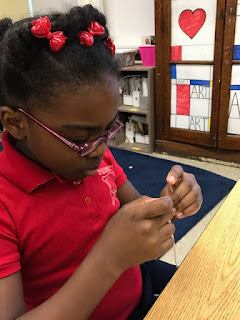 |
| Some of our first practice shapes! |
Tuesday, February 28, 2017
Quilling With Art Club
Paper quilling also known as paper filigree, is the art of shaping paper into intricate and interesting shapes. This is achieved by rolling strips of paper and pinching or curving them into various forms. These forms are then arranged together to create a composition. A completed quilled project may look complicated, but the basics of this medium are actually not hard to master. The Art Club has been experimenting with quilling! They all agree that it is more tricky than it first looked, but they are catching on quickly.
Friday, February 24, 2017
Contour Lines and Creative Thinking
 |
| Albrecht Durer |
 |
| Zithlaly, Grade 7 |
 |
| Quin and Lily, Grade 7 |
 |
| Amir, Grade 8 |
 |
| Mason, Grade 8 |
 |
| Nate, Grade 7 |
 |
| Leo, Grade 7 |
 |
| Danny and Gabe, Grade 8 |
 |
| Cain, Grade 8 |
 |
| Alex, Grade 7 |
 |
| Amanda and Melanie, Grade 8/7 |
Tuesday, February 14, 2017
Marbling Magic
 |
| Finished Patterns |
The second session of Art Club began last week, and we have started with some new projects. I saw this activity online in a few different blogs, and I thought we could give it a try. The students loved it, and I think the prints turned out beautifully. We used shaving cream to cover the bottom of some pans, and dribbled liquid watercolors over the cream. I showed them a few ways to swirl the paint, but also encouraged them to experiment. After swirling the paint, paper could be placed right on top, pressed into the cream, and then the print could be pulled. They used popsicle sticks to stir and scrape. I made sure to provide gloves and to cover the tables because the watercolors can stain skin and tables. I have read that this can be done with food coloring too. Here are some photos of the process and the happy artists!
 |
| Ethan Filling His Pan |
 |
| Javier With His Pan |
 |
| Swirled Paint |
 |
| Esteban With His Pan |
 |
| Elyza Dribbles Paint |
 |
| Sheridan and Jair Pull a Print |
 |
| Javier and His Work |
 |
| Artists at Work |
Saturday, February 11, 2017
Practicing Process
I had the 7th and 8th graders do some exercises this week in mindset, creative thought and art process. Each day, we began class with a short video about growth and fixed mindsets. We worked on quick, one-day projects that challenged them to think of creative ideas and that enabled me to check on their work daily. My hope is that we can begin with longer projects next week referencing these lessons when we hit roadblocks with closed minds or apathy. We have concrete examples going into the quarter of how students came up with new ideas while they were working, how they were able to build on each others' ideas and how practice can improve creativity. The images below show examples from a progressive drawing activity we did yesterday. Students drew what home means to them. They then had to pass their paper around the table while each student was given a task to change or re-draw the original. It was fun to see the changes that took place and ideas that formed through the process!
Tuesday, February 7, 2017
3-D City Sunsets
Subscribe to:
Comments (Atom)
Stormy Seas Ahead
Rembrandt's Stolen Work, Christ in the Storm on the Sea of Galilee My favorite new project this year was one I came up with when I was...

-
As we continue to practice using value and perspective in our artwork, I want you to think about point of view. When we draw something, we ...
-
Our distance learning has had a continued focus on using VALUE and PERSPECTIVE in artwork. This week, you will review ellipses and cyli...
-
The 2018 Prescott School Art Show brought the school community together in honor of art and the environment. I collaborated with science ...






















